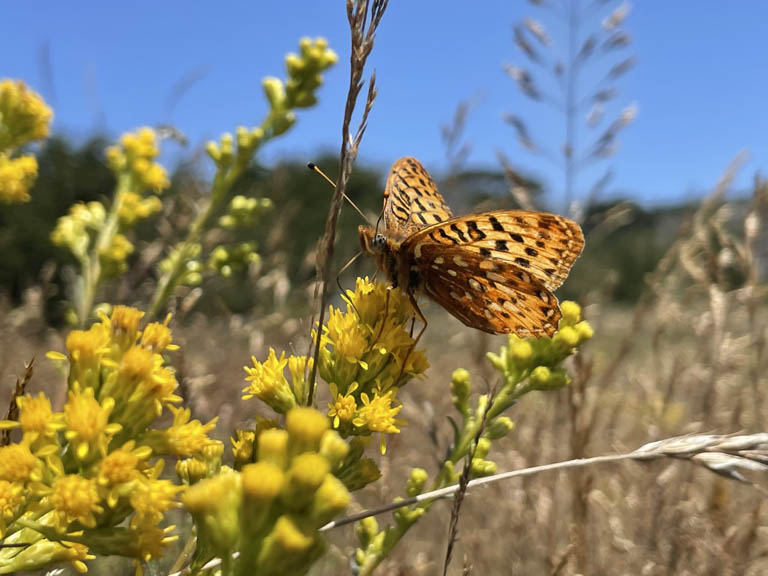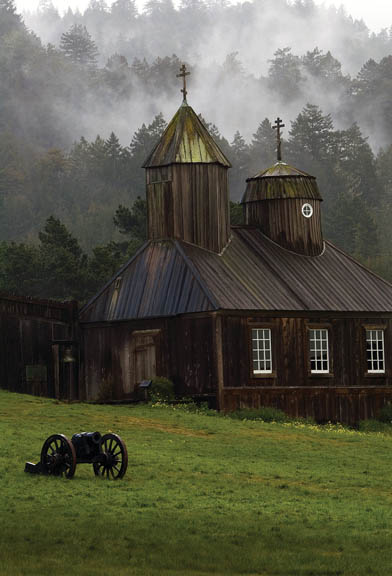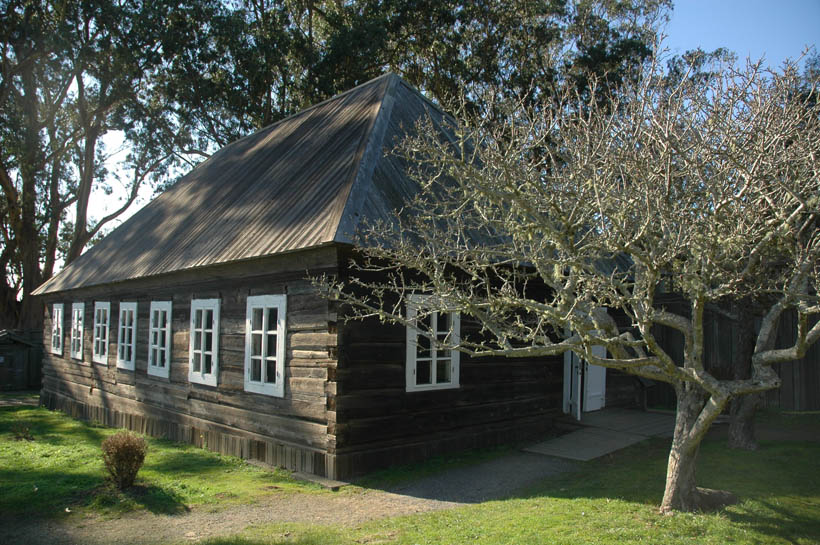Preserving
Fort Ross Conservancy funds a diverse range of projects to ensure both the biodiversity and the cultural heritage of our parks are preserved. This document lists just a few of our projects and collaborations.
Coastal Prairie Restoration for Behren’s Silverspot Butterfly
 The Behren’s Silverspot Butterfly (Speyeria zerene behrensii), which lives in coastal Sonoma and Mendocino counties, was listed as an endangered species in 1997. With funding from the Disney Conservation Fund (DCF), Fort Ross Conservancy and California State Parks have partnered with Florida University and U.S. Fish and Wildlife Service (USFWS) to improve coastal prairie habitat and expand the butterfly’s Viola adunca host plant with the goal of improving habitat needed for the butterfly to survive. Improving the health of native coastal prairie species is essential to growing the maintain and grow their habitat.
The Behren’s Silverspot Butterfly (Speyeria zerene behrensii), which lives in coastal Sonoma and Mendocino counties, was listed as an endangered species in 1997. With funding from the Disney Conservation Fund (DCF), Fort Ross Conservancy and California State Parks have partnered with Florida University and U.S. Fish and Wildlife Service (USFWS) to improve coastal prairie habitat and expand the butterfly’s Viola adunca host plant with the goal of improving habitat needed for the butterfly to survive. Improving the health of native coastal prairie species is essential to growing the maintain and grow their habitat.
The Fort Ross Chapel
 In 2018, Fort Ross Conservancy, the Russian Geographical Society, the Russian Orthodox Church, and the Russian Ministry of Foreign Affairs initiated a research project which was generously underwritten by Ferring Pharmaceuticals to discover as much about the Chapel as historical evidence makes possible. Another important part of the research question was to prove the existence of a bell or bells in the belfry and if possible to find the whereabouts of Fort Ross’ missing bell(s). The multinational research, led by Igor Polishchuk, examined available archival materials of the Russian American Company and the Russian Orthodox Church in Alaska which warrants renovations to the existing Fort Ross Chapel to better reflect its historic record. Some of the research findings include:
In 2018, Fort Ross Conservancy, the Russian Geographical Society, the Russian Orthodox Church, and the Russian Ministry of Foreign Affairs initiated a research project which was generously underwritten by Ferring Pharmaceuticals to discover as much about the Chapel as historical evidence makes possible. Another important part of the research question was to prove the existence of a bell or bells in the belfry and if possible to find the whereabouts of Fort Ross’ missing bell(s). The multinational research, led by Igor Polishchuk, examined available archival materials of the Russian American Company and the Russian Orthodox Church in Alaska which warrants renovations to the existing Fort Ross Chapel to better reflect its historic record. Some of the research findings include:
The Chapel was erected in August 1824 by members of the shipbuilding crew, led by Vasily Grudinin, a peasant from Irkutsk, that completed the construction of the 200-ton brig Kyakhta, the last major ship built at Fort Ross;
- A partial list of building materials available to Fort Ross at the time of Chapel construction;
- Detailed ‘Construction Manual’ of the 19th century pertaining to erecting fortresses;
- A partial list of 30 people who, with high probability, were involved in constructing the first Orthodox Chapel south of Alaska. The Kashia and other Native Americans working at Ross were not acknowledged in the Company’s papers, even though, without a doubt, they would also have participated in the lion’s share of the work;
- The (re)discovery of a set of bells, that author argues belonged to Fort Ross;
- Evidence that the Chapel could have been rebuild during the Russian Period.
California State Parks’ Cultural Resources Division reviewed the report, and noted that the study provides “sufficient information to support the need to make changes to the chapel’s design to better reflect a more authentic reconstruction that will support the overall historic integrity of the National Historic Landmark.” The supported recommendations include:
- Opening up the bell tower as depicted in historic renderings and as recommended;
-
Returning bell(s) to the tower;
-
Painting the copulas’ roofs green;
-
Raising the interior ceiling to documented height to accommodate the iconostasis;
-
Placing iconostasis as described by historic documentation;
-
Addressing termite damage, rot, failing wood, and other related maintenance needs.
The Rotchev House
 The Rotchev House, a National Historic Landmark, is unique and nationally significant because it is one of only four surviving buildings built in the Russian-American colonial period, and the only surviving Russian-built structure outside of Alaska.
The Rotchev House, a National Historic Landmark, is unique and nationally significant because it is one of only four surviving buildings built in the Russian-American colonial period, and the only surviving Russian-built structure outside of Alaska.
FRC has received funding to both preserve and interpret the Rotchev House from:
-
The Sonoma County Landmarks Commission which funded the initial conference of expert advisors, the preparation of a furnishing plan, and crucial preservation – the replacement of all of the decayed doors and windows with handcrafted historically accurate reproductions.
-
California State Parks Cultural Stewardship Grant funds were allocated for analysis of original wooden elements and finishes, conservation of original logs, upgrading the electrical system, and stabilization of the fireplace.
-
The California Cultural and Historical Endowment supported the preparation of the building for exhibits, as well as the first steps of the exhibition – the installation of security and environmental measures, the construction of historic replica interior doors, and the installation of historic painted sailcloth wall coverings.
-
The federal Institute of Museum and Library Services supported the research, architectural plans, translation and publication services, and advisor meetings essential to prepare the exhibit.
-
The National Endowment for the Humanities supported the historical research on which the exhibit is based, the construction of the exhibit displays, and the publication of exhibit information.
-
Renova Fort Ross Foundation funded the installation of a new roof to better protect this important building.